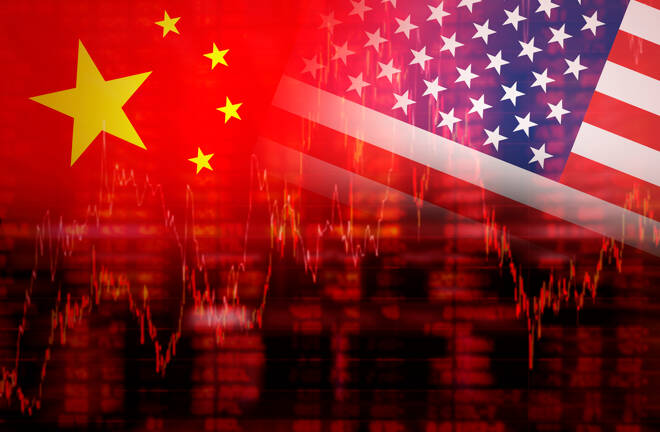Advertisement
Advertisement
US-China Tariff Tensions Deepen: Yuan Stability and Stimulus Silence Test Markets
By:
Key Points:
- UBS cuts China’s 2025 GDP forecast to 3.4% amid tariff hikes and limited stimulus expectations.
- Rare earth export halt signals China’s readiness to escalate the US-China trade war further.
- Weak inflation and declining imports highlight persistent demand-side challenges in China.
US-China Trade War Hits Growth Forecasts
The escalation in the US-China trade war continues to weigh heavily on global markets. Concerns over the impact of elevated tariffs on the US economy have dented appetite for US dollar assets, with 10-year US Treasury yields briefly touching 4.59% on April 11 before pulling back.
Beijing has resisted a Yuan devaluation despite rising export costs. The USD/CNY climbed to 7.3504 per dollar on April 10, its highest since 2008, before easing to 7.3121 on Tuesday, April 15.
Recent tariff developments have raised hopes of dialogue between Washington and Beijing. However, downward revisions to China’s growth forecasts suggest a precarious global outlook.
According to CN Wire, UBS cut its 2025 growth forecast for China to 3.4%, assuming current tariffs persist and additional stimulus is rolled out. UBS noted a high margin of error in its projections.
Some relief came as banks viewed the US decision to exempt certain consumer electronics from 145% tariffs as a possible step toward de-escalation. CN Wire reported:
“Trump’s latest tariff exemptions on consumer electronics and semiconductors could reduce the negative impact on China’s economy by 0.4 percentage points, if it were to last, according to Citi. The reprieve announced Friday covered $100 billion of goods — more than a fifth of total US imports from China last year.
CN Wire went on to say:
“The bank’s economists, including Xiangrong Yu, wrote in a note. That could effectively bring US tariff rates on Beijing down by 28.5 percentage points to about 127.5%, they said. ‘We reckon the tariff dispute could have peaked between the US and China,’ they wrote. ‘Meaningful de-escalation is not in sight yet in our view.’”
China’s Data Underscores Challenges to Boost Domestic Demand
Despite heightened trade tensions, Beijing has yet to unveil fresh stimulus to boost domestic demand. Deflationary pressures remain evident, with consumer prices falling 0.1% year-on-year (YoY) in March after sliding 0.7% in February. Producer prices also signaled weakening demand, declining 2.5% YoY in March after falling 2.2% in February. Producers cut prices as demand wanes, passing cost savings on to customers.
China’s trade data indicated a similar trend. While exports surged, imports declined 4.3% year-on-year in March after dropping 8.4% in February.
Peter Schiff, Chief Economist and Global Strategist at Euro Pacific Asset Management, commented:
“Many claim China won’t sell Treasuries as doing so would strengthen the Yuan, which they say would damage China’s exports. But US tariffs are now so high that a weaker Yuan won’t move the needle. China is better off with a stronger Yuan to improve domestic demand.”
While Schiff supports a stronger Yuan to support demand, others like Alicia Garcia Herrero believe currency weakening could serve as leverage.
Alicia Garcia Herrero, Asia Pacific Chief Economist at Natixis, stated:
“Beijing could also let the Yuan weaken further, putting pressure on the dollar, or stoke speculation about selling Treasuries. China still has a lot of leverage, a lot. More so because the US economy won’t do well, especially in the second half of the year so leverage might actually increase rather than decrease.”
Despite domestic demand challenges, Beijing’s restraint on stimulus may reflect a strategy to wait out the Trump administration’s tariff approach.
However, recent warnings and China halting rare earth mineral shipments to the US signal China’s willingness to escalate tensions if necessary.
Tariff Uncertainties Impact Hong Kong and Mainland China Equities
Initial resilience to US tariffs has faded across Hong Kong and Mainland China markets. Investor sentiment has weakened amid heightened trade tensions and the absence of fresh stimulus.
Notable equity moves include:
- Hang Seng Index down 7.49% in April, narrowing its year-to-date (YTD) gain to 6.65%.
- Shanghai Composite Index off 3.57% in April and down 4.72% YTD.
- Nasdaq Composite Index down 2.7% in April, extending its YTD decline to 12.84%.
Outlook
Markets will likely remain sensitive to tariff-related headlines and Yuan policy shifts. A US pivot from reciprocal tariffs to national security tariffs, targeting semiconductors and the electronics supply chains, could fuel risk aversion. However, a Yuan devaluation may help mitigate the effects of tariffs and support China’s transition toward a consumption-led economy.
Stay with us for in-depth coverage of China’s economic trajectory and global market implications.
About the Author
Bob Masonauthor
With over 28 years of experience in the financial industry, Bob has worked with various global rating agencies and multinational banks. Currently he is covering currencies, commodities, alternative asset classes and global equities, focusing mostly on European and Asian markets.
Did you find this article useful?
Latest news and analysis
Advertisement
